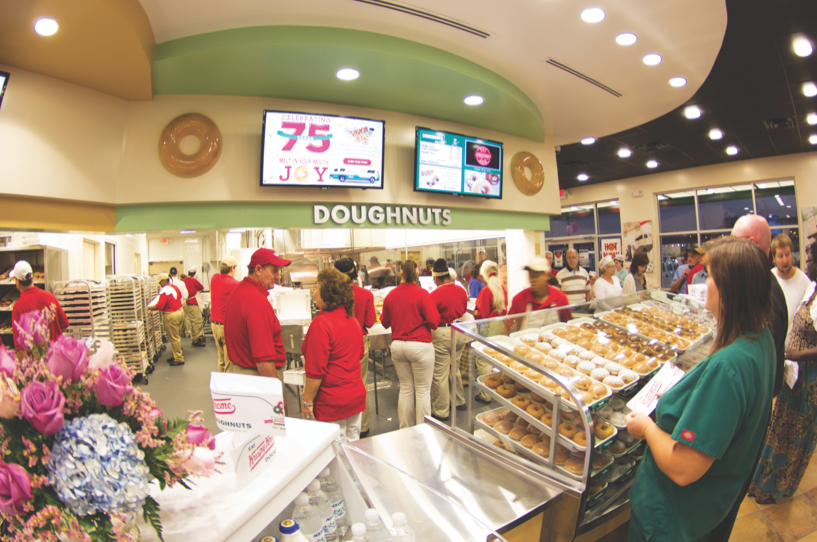By Jordan Cissell
Staff Reporter
^
If there is one thing Evan Smith knows about rebuilding a restaurant from scratch, it’s that the process is not an easy one.
“I’ll tell you what I’ve been telling everyone else about this stuff – I definitely don’t want to go through that ever again,” Smith, the general manager of Tuscaloosa’s Krispy Kreme and a member of the family that opened West Alabama’s first location in 1960, said. “I know that for sure.”
Following the destruction of its building during the April 27, 2011 tornado, Smith and Krispy Kreme set to work on reconstructing at the same location on McFarland Boulevard. After the year-long process, the store reopened on Aug. 21 of this year.
Despite Smith’s arduous assessment of the rebuilding process, Krispy Kreme has not been alone in making its return.
“In Tuscaloosa, 242 commercial structures were damaged, and 114 were destroyed,” Tuscaloosa Mayor Walt Maddox said in an April 16 statement entitled, “The Facts of Tuscaloosa’s Recovery,” on the Tuscaloosa Forward website. “Since April 27, [2011], 93 percent of the 242 commercial structures that were damaged have received repair permits, and 34 percent of the destroyed structures have received new construction permits.”
City of Tuscaloosa Communication Director Diedre Stalnaker said she could not say for certain what percentage of the damaged or destroyed businesses operated in the food service industry.
Both local institutions — like Hokkaido and Mike and Ed’s Bar-B-Que — and corporate chains — like Full Moon Bar-B-Que and McDonald’s — have joined Krispy Kreme in reopening for business.
“It’s important to note that some restaurants have reopened in a different location, such as Hokkaido and Full Moon. Other restaurants plan to reopen with a different name – Mike & Ed’s will be Hoo’s-Q,” Stalnaker said. “Some restaurants have reopened in the same location, such as Taco Casa and McDonald’s.”
Smith said family tradition played a very significant role in Krispy Kreme’s decision to return to its old location.
“We were adamant about coming back to our same place there on McFarland, because that’s where my grandparents started it,” Smith said. “There was no question that we were coming back in that spot.”
This adamancy on location ended up substantially delaying Krispy Kreme’s return. Smith said the length of time spent physically reconstructing paled in comparison to the months spent working out pre-build kinks.
“When we started to try to rebuild, we found out we were in a flood plain, so we weren’t allowed to build. So we hired a water expert who did some research and proved to the city that we weren’t in a flood plain,” Smith said. “Then there was another delay because the State Department was considering buying land along McFarland to widen the turning lanes. Once that all got straightened out, we got the building completed in only about four months.”
Smith said finances were not a significant factor in Krispy Kreme’s decision to rebuild, but the city of Tuscaloosa took measures to aid the return of restaurants for which money was an issue.
“The city of Tuscaloosa is currently offering a Commercial Revolving Loan Program to assist businesses developing in areas hardest hit by the tornado, and restaurant owners are eligible to apply,” Stalnaker said. “The program is funded through a FEMA hazard mitigation grant and offers recipients a zero interest loan, ranging in amount from $20,000 to $200,000.”
As part of the Tuscaloosa Forward plan, the City plans to “create well-designed mixed-use corridors that serve as attractive gateways to the community and support the city’s retail and service needs,” according to the plan outline. The Plan highlights 10th Avenue, 15th Street and University Boulevard as major corridors affected by the tornadoes, but Smith thinks McFarland’s dense traffic flow merits its inclusion in the list.
“You really couldn’t find a better location in town,” he said.
Smith said decreasing, or at least more efficiently managing, traffic flow would probably prove more beneficial for restaurants and businesses along McFarland Boulevard, as congested driving conditions can discourage potential patrons.
Stalnaker said Tuscaloosa’s high population and traffic flow serves as encouragement for business owners facing the rebuilding decision.
“Heavy traffic and a large student population – high potential for customers – are all examples of incentives that could impact a restaurant’s decision to build or rebuild in the recovery area.”
Smith echoed Stalnaker’s sentiment. He said the University’s large student population never hurts when one is in the business of selling donuts.
“The City has been great, the University has been great, and all of the Tuscaloosa residents and students have been very supportive. And they have let us know it,” Smith said. “I’m just happy we’re past it all, and we’re glad to be open again.”









